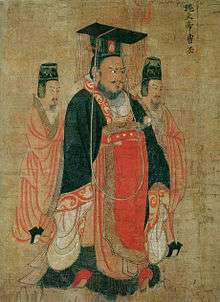220
This article is about the year 220. For the Phil Keaggy album, see 220 (album).
| Millennium: | 1st millennium |
|---|---|
| Centuries: | 2nd century · 3rd century · 4th century |
| Decades: | 190s · 200s · 210s · 220s · 230s · 240s · 250s |
| Years: | 217 · 218 · 219 · 220 · 221 · 222 · 223 |
| 220 by topic | |
| Politics | |
| State leaders – Sovereign states | |
| Birth and death categories | |
| Births – Deaths | |
| Establishment and disestablishment categories | |
| Establishments – Disestablishments | |
| Gregorian calendar | 220 CCXX |
| Ab urbe condita | 973 |
| Assyrian calendar | 4970 |
| Bengali calendar | −373 |
| Berber calendar | 1170 |
| Buddhist calendar | 764 |
| Burmese calendar | −418 |
| Byzantine calendar | 5728–5729 |
| Chinese calendar | 己亥年 (Earth Pig) 2916 or 2856 — to — 庚子年 (Metal Rat) 2917 or 2857 |
| Coptic calendar | −64 – −63 |
| Discordian calendar | 1386 |
| Ethiopian calendar | 212–213 |
| Hebrew calendar | 3980–3981 |
| Hindu calendars | |
| - Vikram Samvat | 276–277 |
| - Shaka Samvat | 141–142 |
| - Kali Yuga | 3320–3321 |
| Holocene calendar | 10220 |
| Iranian calendar | 402 BP – 401 BP |
| Islamic calendar | 414 BH – 413 BH |
| Javanese calendar | 98–99 |
| Julian calendar | 220 CCXX |
| Korean calendar | 2553 |
| Minguo calendar | 1692 before ROC 民前1692年 |
| Nanakshahi calendar | −1248 |
| Seleucid era | 531/532 AG |
| Thai solar calendar | 762–763 |
| Wikimedia Commons has media related to 220. |

Emperor Cao Pi and his ministers
Year 220 (CCXX) was a leap year starting on Saturday (link will display the full calendar) of the Julian calendar. At the time, it was known as the Year of the Consulship of Antonius and Eutychianus (or, less frequently, year 973 Ab urbe condita). The denomination 220 for this year has been used since the early medieval period, when the Anno Domini calendar era became the prevalent method in Europe for naming years.
Events
By place
Roman Empire
- The Goths invade Asia Minor and the Balkans.
- An Indian delegation visits the Roman emperor Elagabalus.
- Great frost in England is said to have lasted for five months.[1]
- Imperator Marcus Aurelius Antoninus Augustus (Elagabalus) and Publius Valerius Comazon become Roman consuls.
- Elagabalus divorces Julia Paula and marries Aquilia Severa, a Vestal Virgin. The wedding causes an enormous controversy – traditionally, the punishment for breaking celibacy is death by being buried alive.
- King Ardashir I, founder of the Sassanid dynasty, gains support from some Parthian sub-kings and revolts against the rule of Vologases VI. Ardashir, a grandson of Sasan, had ruled Persis since 208 and six years ago gained control of the region surrounding Persepolis.
Asia
- Three Kingdoms: The northern part of China is under the control of Cao Cao, Imperial Chancellor and ruler of the Kingdom of Wei. Following his death on March 15, his son Cao Pi receives the abdication of Emperor Xian of Han on December 10, and proclaims himself emperor of Cao Wei. This ends the Han dynasty, the former emperor being created Duke of Shanyang.
By topic
Religion
- The Wei dynasty will give official recognition to Taoism as its religious sect, and the sect's celestial masters will reciprocate by giving spiritual approbation to the Wei as successors to the Han. By the end of the century most powerful families in northern China will subscribe to Daoist principles.
Births
- Wei Guan, general of the Kingdom of Wei (d. 291)
Deaths
- March 15 – Cao Cao, self-appointed prime minister of the Han dynasty (b. 155)
- June 13 – Xiahou Dun, general and relative of Cao Cao
- December – Cheng Yu, advisor of Cao Cao (b. 141)
- Ding Yi, minister of the Kingdom of Wei
- Fa Zheng, advisor to Liu Bei (b. 176)[2]
- Guan Yu, general of Liu Bei
- Huang Zhong, general under Liu Bei
- Liu Feng, Shu general (executed by Liu Bei) (b. 192)
- Lü Meng, general of Sun Quan (b. 178)
References
- ↑ Stratton, J.M. (1969). Agricultural Records. John Baker. ISBN 0-212-97022-4.
- ↑ Lühmann, Werner (2003). Konfuzius: aufgeklärter Philosoph oder reaktionärer Moralapostel? : der Bruch in der Konfuzius-Rezeption der deutschen Philosophie des ausgehenden 18. und beginnenden 19. Jahrhunderts. Harrassowitz. p. 68. ISBN 978-3-447-04753-1.
This article is issued from Wikipedia - version of the 9/21/2016. The text is available under the Creative Commons Attribution/Share Alike but additional terms may apply for the media files.